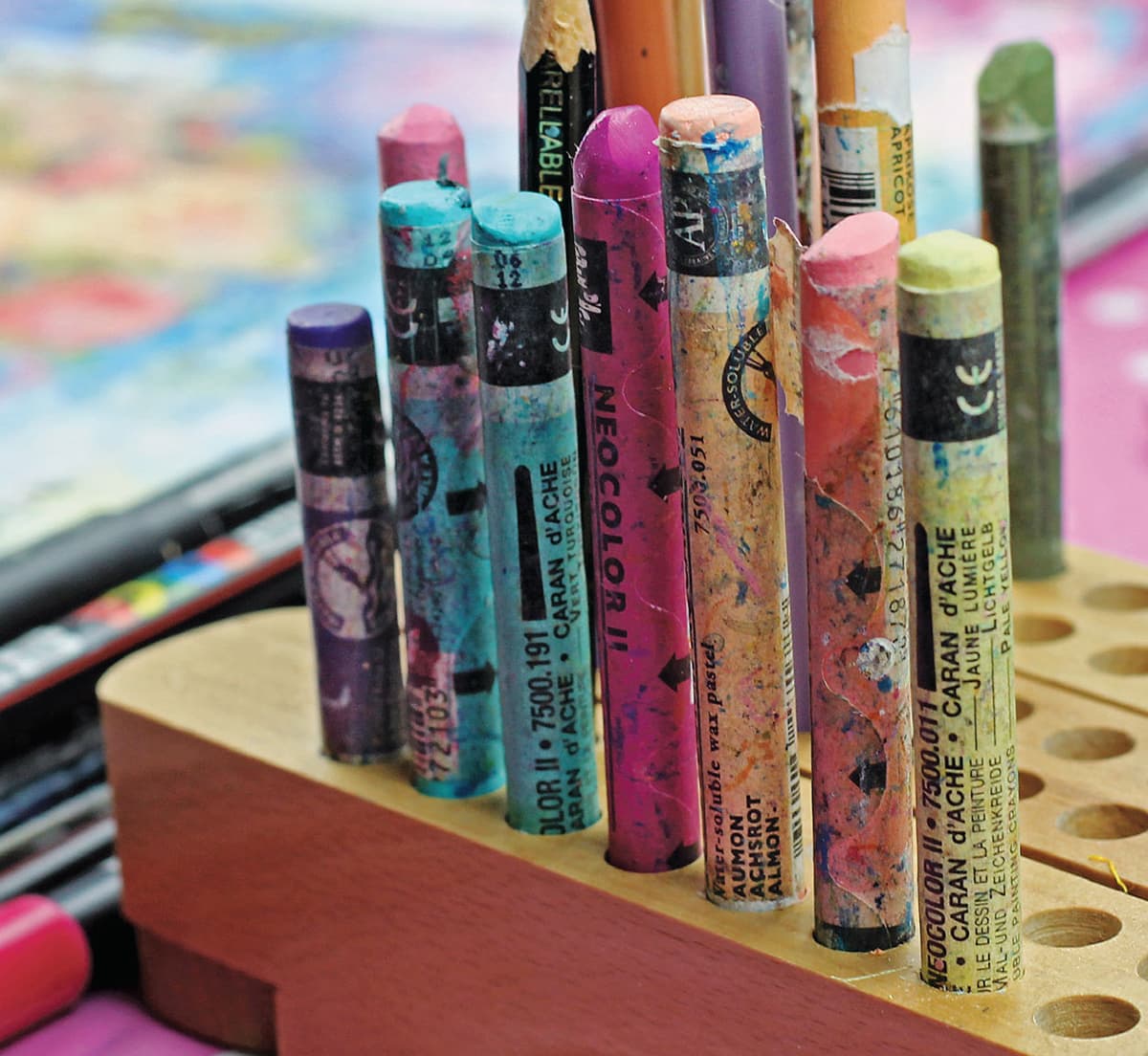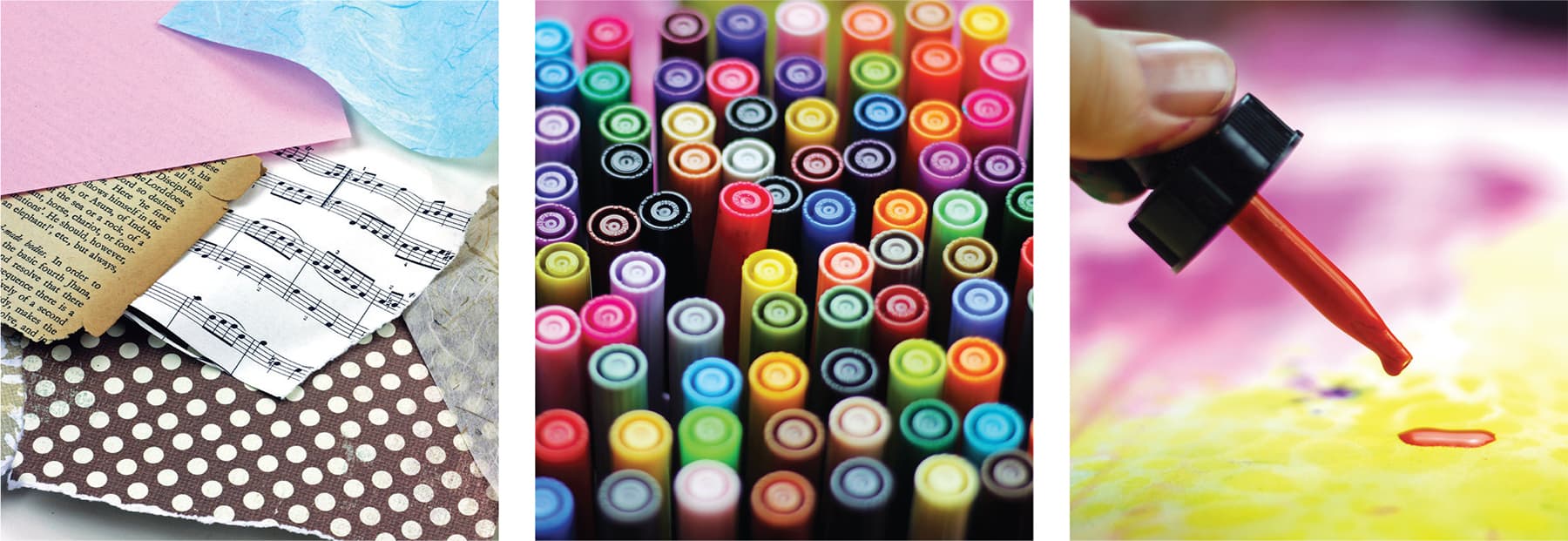About Art Supplies


IN THIS BOOK, you will be introduced to a wide variety of materials and supplies. You do not need to buy them all. Many of the products used in this book can be replaced with other products you may already have or cheaper alternatives. Initially work with what you already have; if a particular product really speaks to you, you may want to buy it later.
Here is a list of products used in this book and possible substitutions for them, where applicable.
PAPER
• I work on 140 lb (300 g/m2) hot pressed watercolor paper. Brand-wise, I usually use Daler-Rowney or Saunders Waterford, but Fabriano, Strathmore, or Canson would also be fine. I work either on 9 × 12 inch (23 × 30.5 cm) or 12 × 16 inch (30.5 × 41 cm). Cold pressed is fine, too. (Hot or cold pressed becomes a personal preference over time; cold pressed paper has a grain while hot pressed paper is smooth.) Don’t go for less than 140 lb (300 g/m2) in weight.
» SUBSTITUTES: I tend not to compromise on paper because wet work is hard on paper. You need high quality paper so it withstands the kind of mixed-media work we do in this book.
• You can also do these projects in an art journal or on canvas, wood, or board. These substrates will respond slightly differently to your supplies. It’s fun to explore and discover how all your supplies and substrates interact. A few projects in this book are demonstrated on canvas and canvas board.
PAINTS & CRAYONS
• Water-soluble crayons such as Caran d’Ache Neocolor II artists’ crayons.
» SUBSTITUTES: Any watercolor paints or watercolor pencils. Note: These may not be as vibrant as the crayons.
• Golden Heavy Body Acrylic Paints.
» SUBSTITUTES: Daler-Rowney or Winsor & Newton heavy body acrylic paints. Even student-grade paints will be fine if you are just beginning.
• Golden Fluid Acrylic Paints. These are expensive, so if you want to try them out, buy two or three of your favorite colors to start with.
» SUBSTITUTES: Water-down heavy body acrylics or add glazing or matte medium to your heavy body acrylics. Some other cheaper brands also do fluid acrylics.
• Fun but expensive and optional: Golden High Flow Acrylic Paints. Get only a few if you want to try them.
» SUBSTITUTES: Fluid acrylics or watered-down heavy body acrylic paints can create a similar effect. You can also use acrylic markers (such as Posca markers) to achieve a similar effect. The downside is that the colors vary by brand.
PENCILS
• Colored pencils by brands such as Prismacolor or Caran d’Ache Luminance.
• Water-soluble colored pencils by brands such as Derwent or Stabilo All.
• Graphite pencils, 2B and heavier. I like the Graph Gear 1000 by Pentel, but any pencil will do. Mechanical ones are better for finer detail.
MEDIUMS, PASTES, & GESSOS
• Gel medium such as Daler Rowney Impasto Gel for gluing collage materials. Avoid water-based glues for collage because they will dry out over the years and your collage may peel off.
• For acrylic transfers, you’ll get best results with Golden Gel Medium, preferably soft matte.
• White gesso, such as Winsor & Newton, Liquitex, or Golden.
• Transparent or clear gesso such as Liquitex.
• Molding paste such as Golden, Liquitex, or Winsor & Newton.
• Crackle medium.
COLLAGE SUPPLIES
You’ll need a variety of patterned scrapbooking papers, magazine pages, book pages, musical scores, and photos. I also often use washi tape as part of my collages.

TOOLS
• Brayer by Speedball.
• Palette knife, optional; you could also use an old plastic card.
• Craft knife by Stanley or X-ACTO.
• Scissors.
• Ruler.
• Eraser.
• Heat gun or hair dryer.
• Brushes. I like Pro Arte Acrylix brushes, but any soft-haired firm brushes will do. Avoid brushes with coarse hair; you want soft but firm.
MARKERS & PENS
• Posca markers or Poster-Paint Sharpies in black and white, fine-nibbed and thicker nibbed.
• Tombow markers.
» SUBSTITUTES: Any water-soluble, ink-based markers such as Aqua Markers by Letraset or Sakura markers.
• Gel pens in metallic colors such as silver and gold.
INKS & SPRAYS
• Dylusions Ink Sprays. Start with a few.
• Daler Rowney FW Artists’ Acrylic Ink.
STAMPING & STENCILING SUPPLIES
I use decorative rubber stamps and a selection of stencils. You’ll also need waterproof ink pads such as StāzOn.
OTHER SUPPLIES
• Brass fasteners.
• Cotton swabs (Q-Tips).
• Gold leaf.
• Blending stump.
• Hole punch.
• Ribbons, string, yarn, and thread.
• Buttons, metal wire, and a small silver key (optional).
• Magazines, newspapers, and a printer
• Crystals (for Project 16).
• PanPastel artists’ painting pastels, optional (for Project 9).
• Old plastic card.
• Found items from around the house, such as leftover tissue rolls, old kids toys, or cups for unusual stamping and mark-making.
NOTEBOOK
I recommend getting yourself a notebook—your Life Book Notebook—to write notes in if any ideas, feelings, or needs come up. You can also use it for the writing exercises described in this book.

